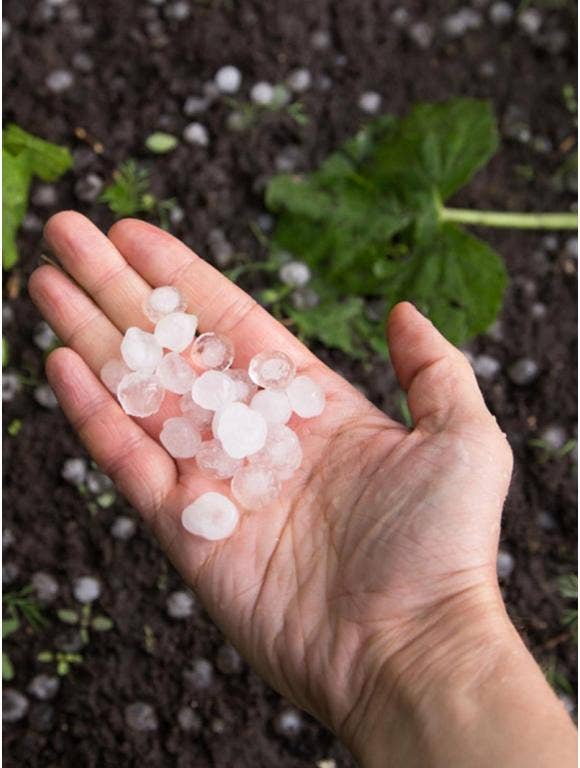
When a storm passes through, your garden often bears the brunt of it. It can be extremely disheartening to look out at the landscape the morning after and see months, even years, of loving care seemingly washed down the drain. You may find broken branches, battered foliage and flattened stems — it can feel like a disaster.
However, try to keep an open mind about how to revive a vegetable garden. Remember, nature is a great healer. Storms have occurred for millennia, and plants are resilient — they have to be. Going all the way back to prehistoric times when woolly mammoths trampled over them, plants have learned to adapt to adversity.
Here's what you can do to revive your vegetable garden after a storm.
Assess the Damage
First, take a walk around the garden to determine the extent of the damage and what needs to be done. Some things take precedence over others. Raking can wait, but uprooted plants need to be set back in place before exposed roots dry out.
Lift Flattened Plants
As you're inspecting the damage, look for any plants that were flattened by heavy rain or hail. These can often be lifted back into place and salvaged, although they might require support for the remainder of the growing season. Gently rinse any dirt or mud off the leaves to avoid foliar diseases.
Fix Broken Stems
Here's how to fix a broken plant stem: Make a clean cut below the break so there are no jagged edges. If there's a bud or leaf node, a swollen area where a leaf was once attached, cut back to within a quarter-inch above it. Many plants will put out new growth from the remaining portion of the stem.
Inspect Tattered Foliage
Large leaves, like those of rhubarb, kale and collard greens, are most susceptible to storm damage. If they're broken or turn yellow or brown, remove them with pruners. Otherwise, allow them to remain as they're needed for photosynthesis.
Cover Exposed Roots
Wind and rain sometimes expose plant roots, which will quickly dry out in the sun. Cover any exposed roots with topsoil and add a layer of mulch to keep the fresh soil from eroding.
Dump Excess Water
Pots, saucers, wheelbarrows and other items around the yard collect stormwater and invite mosquitoes, so dump any water that accumulates. Also, inspect gutter spouts and remove any leaves or debris clogging the exits.
Weed if Possible
After a storm, the soil is moist, and you can easily pull up weeds at that time. With less competition, the remaining plants can fare better. Hold off, though, if the soil is mushy or mucky from excess rain — you can damage the soil structure by walking on it then. If you need to get in the vegetable garden when the soil is still mucky, lay down a board and walk on that to distribute the weight.
Aerate Dry Soil
Once gardens dry out, powdery soils (more common where the soil has been overly tilled) will often form an impenetrable glaze-like barrier after a hard rain. Use a spade fork to break the plane. Long term, start to amend the soil with compost and shredded leaves to restore its health.
Replace Mulch
A storm can displace mulch on a slope or near a gutter spout. Bark chips are especially prone to floating away on a river of water. Replace the mulch where needed and beef it up in places where it appears thin. Consider the Ruth Stout method of mulching, which is to surround your plants with straw, leaves, garden prunings and other organic material. It conserves moisture, builds up soil slowly over time and prevents heavy downpours from eroding your precious garden soil.
Remove Damaged Plants
It's a tough call, but sometimes the answer to the question of how to revive a vegetable garden after a storm is to remove plants. This would certainly be the case if the plant is broken off at the base, but it can also be true if most of the foliage was badly damaged. Dig up the plants and roots, while being careful not to damage surrounding plants and root systems.
Replant if Needed
Look at the calendar and determine whether there's time to put in replacement plants. Early on in the gardening season, you'll luckily have numerous options for replanting. If you're closer to the fall and frost dates, do some research for vegetables or annuals that can withstand cooler weather — there are plenty of quick-growing options that may still work.
Fertilize if Desired
Hold off fertilizing for a few weeks to see if plants can respond on their own. After that, you can lightly fertilize, applying a water-soluble fertilizer at half-strength.
Call in Help
After a storm, don't be afraid to call in help, especially when it comes to safety. Be sure to stay away from any downed power lines and call the power company for service. Also, don't try to tackle any large limbs hanging down from a tree (they're called widowmakers for a reason) unless you have experience dealing with fallen trees and branches. It's better to call a tree service than be injured by a falling limb.
While your garden may feel like a lost cause after a big storm, following these steps can help you mitigate any damage to let your vegetables thrive for the remainder of the season.
For more tips on maintaining your garden, check out Burpee's Care and Maintenance garden guide.



